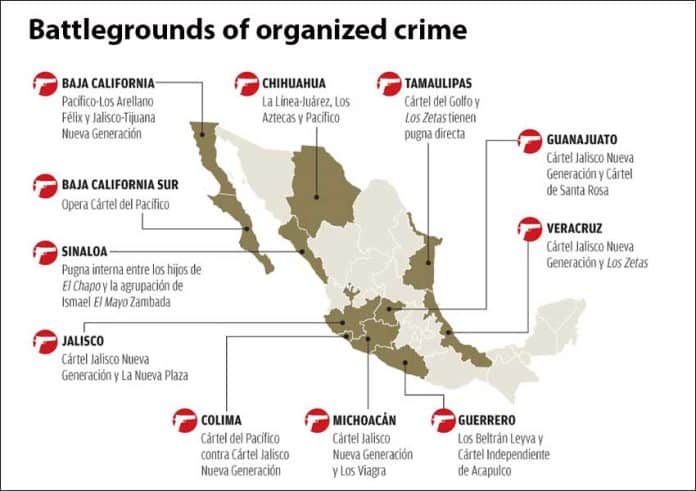Fifteen warring drug cartels are behind the wave of violence sweeping across parts of Mexico, according to new intelligence reports from the National Security Commission (CNS).
The reports, updated this month and informed by intelligence provided by the Federal Police and the Secretariat of National Defense (Sedena), identify turf wars between criminal organizations to control the “plaza” — and consequently criminal activity — in different regions of the country as the main reason for rising levels of violent crime.
Internal disputes within cartels and the splintering of criminal organizations into smaller groups are other factors driving up crime rates, National Security Commissioner Renato Sales said.
Guanajuato has become the epicenter of a war between the Jalisco New Generation Cartel (CJNG) and the Santa Rosa de Lima Cartel that is fueled mainly by the ambition to control the lucrative pipeline petroleum theft racket and to a lesser extent drug trafficking, the CNS said.
Violence has surged in the state this year, with more intentional homicides in the first six months of the year than the total number recorded for all of last year, according to the National Public Security System (SNSP).
Farther north, the Sinaloa Cartel — formerly headed by Joaquín “El Chapo” Guzmán — is involved in bloody infighting between one faction headed by the infamous capo’s sons and another led by Ismael “El Mayo” Zambada.
El Chapo was extradited to the United States in January last year and is currently awaiting trial on charges of drug trafficking, money laundering, kidnapping and murder.
In Baja California, high homicide numbers are attributed to a turf war between an alliance made up of the Sinaloa and Arellano Félix cartels and another consisting of the CJNG and the Tijuana New Generation Cartel.
To the east in Chihuahua, and especially in the border city of Ciudad Juárez, a battle between La Línea and Los Aztecas gangs to control the “plaza” is responsible for a large part of the current violence.
The former gang is a unit of the Juárez Cartel while the latter, also known as Barrio Azteca, was previously in alliance with La Línea.
In Guerrero, the port city and tourist draw Acapulco continues to be plagued by violence due to a dispute between the Beltrán Leyva Cartel and the Independent Cartel of Acapulco to control drug trafficking and extortion.
In Jalisco, where violence has also increased this year, the CJNG and the New Plaza Cartel are engaged in a violent dispute.
The former was allegedly responsible for the abduction and murder of three film students near Guadalajara in March and the attack in May on Luis Carlos Nájera, the former attorney general of Jalisco who is now the state’s labor secretary.
Turf wars in Tamaulipas between the Gulf Cartel and Los Zetas; in Veracruz between the CJNG and Los Zetas; in Colima between the Sinaloa Cartel and the CJNG; in Michoacán between Los Viagra and the CJNG; and in Durango between the Sinaloa Cartel and the Cártel del Poniente (West Cartel) are behind a high number of the homicides in those states, the CNS said.
Other cartels the commission cited in its reports are the Cártel del Noreste (Northeast Cartel) — a faction of Los Zetas — and La Familia Michoacana.
Rising levels of violent crime in Ciudad Obregón, Sonora, was the trigger for a large protest in that city yesterday.
Hundreds of demonstrators, mainly dressed in black, marched for two kilometers from the north of the city to the municipal headquarters.
Among the participants were family members of scores of victims of homicide and kidnappings.
Homicide figures for the first six months of 2018 were up 15% compared to the same period last year, making the January to June period the most violent of at least the past two decades.
Source: Milenio (sp)
